31 January 2025
How to Choose the Best Mobile App Development Company for Your Business Read MoreI have a Dating app development idea, but i don’t know where to start from?
You are not alone. When entrepreneurs or startups search for how to create a dating app or “dating app development cost” they’re often met with oversimplified solutions and estimates that can derail entire projects.
The truth about developing dating applications and the related costs goes well beyond the initial phase of development, including unforeseen expenses that could potentially double your budget if not planned carefully.
Are you ready to invest in dating apps and wondering what the dating app development cost?
Actually the cost to develop a dating app typically varies between $20,000 to $100,000. The cost here depends on various reasons like geographical location, app type, app complexity, team location, and development time required. These factors significantly affect the overall costs.
Here is a straightforward dating app development cost breakdown estimation for key phases
| Phase | Estimated Cost |
|---|---|
| Planning and Discovery | $2,000 – $15,000 |
| UX/UI Design | $3,000 – $20,000 |
| Frontend Development | $15,000 – $30,000 |
| Backend Development | $12,000 – $25,000 |
| Testing and QA | $3,000 – $15,000 |
| Total | $35,000 – $100,000 |
Key Takeaway: Your dating app success begins here!
The above figures don’t lie—the dating app market opportunity is all yours to conquer. But how?
Let’s explore the comprehensive breakdown of dating app development costs—from building a simple MVP to scaling into a dominant market leader in 2025 and beyond. This guide gives you strategic insights on careful budgeting, aligning technical capabilities with achievable timelines, and optimizing costs while maintaining quality and scalability.
Here is the right time to know how to create a dating app with Dev Story. Stay Tuned!
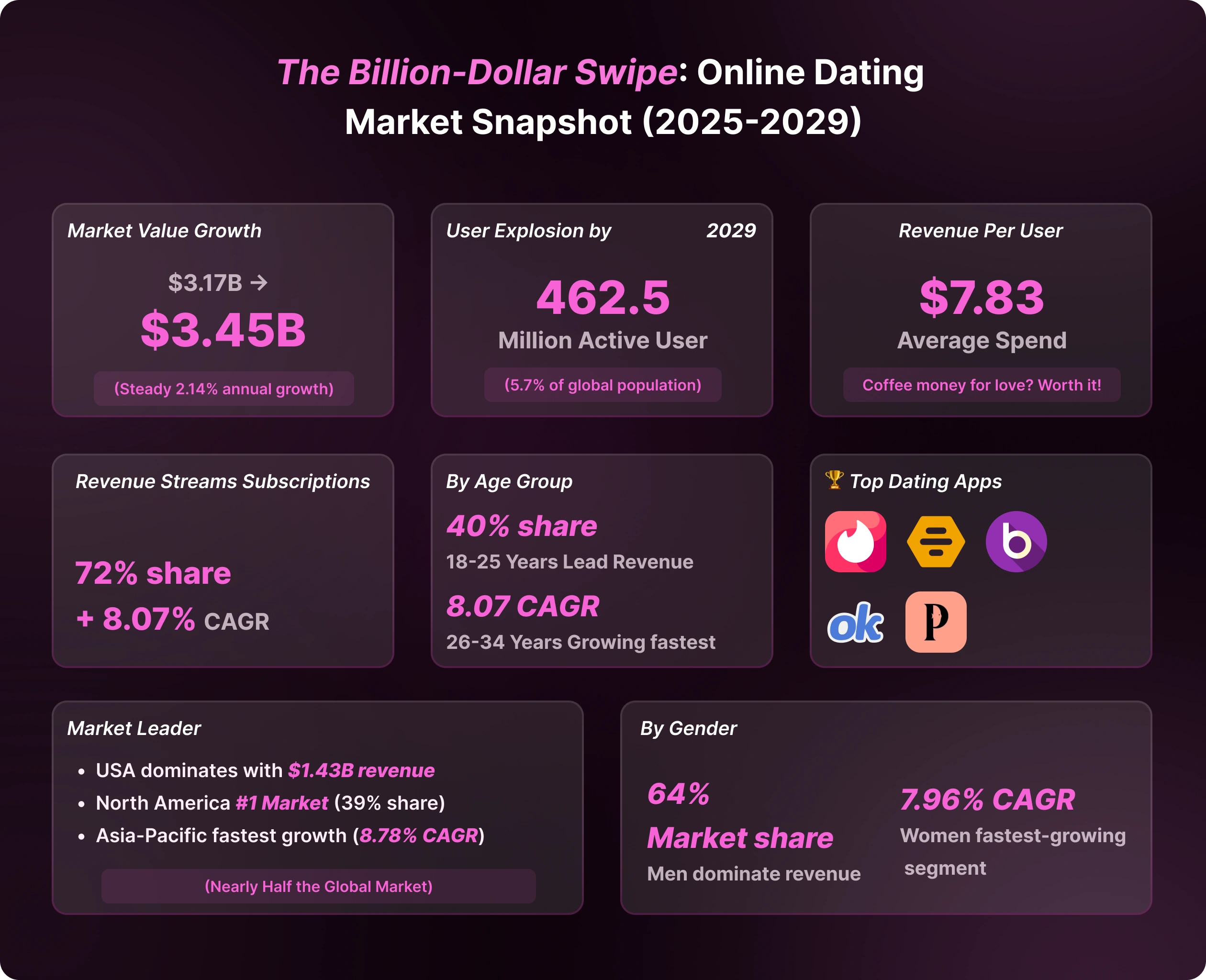
Online Dating App Market Breakdown (2024-2032)
The global dating app market is undergoing fast expansion, fueled primarily by the worldwide adoption of smartphones across both developed and developing economies.
Simultaneously, the industry is undergoing transformation due to technological advancements, especially with the incorporation of artificial intelligence and machine learning functionalities.
The merging of these two trends – increasing mobile accessibility and the sophistication of AI-driven matchmaking – fosters a vibrant growth landscape for dating services.
As digital access deepens in emerging markets and algorithmic technologies progress, the opportunity for innovative applications to seize market share is rapidly increasing. This dual path indicates that the future leaders in the market will be those platforms that successfully utilize both extensive mobile accessibility and state-of-the-art matching technologies to provide enhanced user experiences.
Looking at the stats, I think it is the right time to invest in the dating app without thinking of how much does it cost to create a dating app?
How much does it cost to make a dating app the reality check: Why most estimates are wrong
Industry myth-busting: The “$25,000-$125,000” Misconception
Many online sources estimate the cost of developing a dating app to be between $20,000 and $1,00,000; however, this range can be quite misleading. These figures usually reflect only the fundamental development stage, overlooking essential elements that contribute to actual success in the market. The expenses associated with creating a dating app encompass much more than mere coding and design.
Industry estimates are flawed as they adopt a one-size-fits-all mindset. A dating app aimed at college students requires different infrastructure as compared to one intended for professionals aged over 40.
On other hand factors like geographic location, the size of the target audience, and the monetization strategy significantly affect the cost of building a dating app features that can effectively generate revenue.
A prevalent misconception is that development concludes upon the app’s launch. But the reality is, successful dating apps demand ongoing investment in user acquisition, server scaling, security updates, and feature improvements are also dating app development cost factors. Companies that allocate funds solely for initial development often discover they are unable to sustain competitive features or accommodate user growth.
The Hidden 60% Rule: Post-Launch Dating App Development Cost Factors Everyone Ignores
The 60% rule is a well-guarded secret within the industry: for every dollar allocated to initial development, successful dating applications invest an additional 60 cents in post-launch activities during the first year. Consequently, a dating app with an initial development cost of $50,000 realistically needs an extra $30,000 in investment for the first year alone for the post launch and maintenance.
Post-launch costs encompass server scaling costs, which can surge by 300% as the user base expands, ongoing security updates to safeguard user data, customer support infrastructure, and continuous feature development to remain competitive. Marketing and user acquisition generally account for 40-60% of the total budget for the first year; however, most cost assessments entirely overlook these critical expenses.
Another hidden cost in dating app development is content moderation, which can amount to $5,000-$15,000 monthly for applications with active user bases. Dating apps are required to invest significantly in AI-driven content filtering, human moderation teams, and automated systems to identify inappropriate behavior. These costs increase directly with user growth, rendering them unpredictable yet unavoidable.
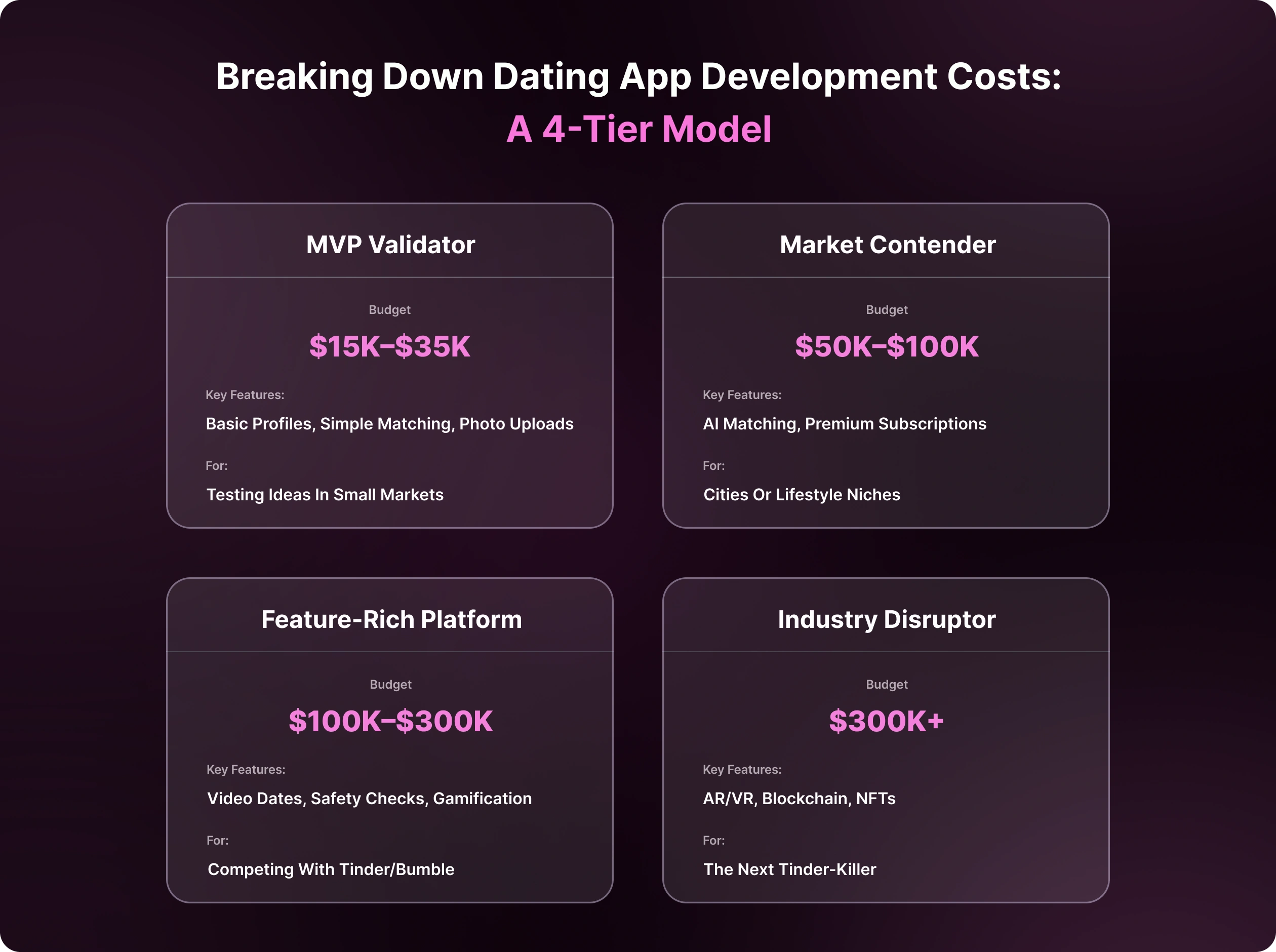
Comprehending the actual cost of building a dating app demands a framework that aligns the level of investment with achievable results. This four-tier structure offers precise budgeting grounded in real market positioning and business objectives.
The MVP Validator tier emphasizes proof of concept over market supremacy. The cost range for developing a dating app in this tier encompasses the fundamental functionalities required to assess market demand and user behavior trends.
| Feature | Estimated Cost |
|---|---|
| User registration and basic profile creation | $3,000-$5,000 |
| Basic matching algorithm based on location and age | $4,000-$8,000 |
| Elementary messaging system lacking advanced features | $3,000-$6,000 |
| Photo upload and basic moderation | $2,000-$4,000 |
| Simple admin panel for user management | $2,000-$5,000 |
| Basic push notifications | $1,000-$2,000 |
Industry Competitor applications engage in cutthroat competition within regional markets, providing advanced features that differentiate them from the basic competitors. This cost of dating app development tier encompasses sophisticated matching and user experience components.
| Advanced Feature | Estimated Cost |
|---|---|
| AI-enhanced matching algorithms (personality-based) | $8,000-$15,000 |
| Advanced search filters and user preferences | $5,000-$10,000 |
| Real-time chat with media sharing | $6,000-$12,000 |
| Profile verification system | $4,000-$8,000 |
| Premium subscription management | $5,000-$10,000 |
| Social media integration | $3,000-$6,000 |
| Advanced analytics & user behavior insights | $4,000-$8,000 |
Feature-rich platforms compete on a national scale, providing extensive dating experiences that challenge established competitors. The cost associated with developing a dating app tier encompasses state-of-the-art technology and a wide array of user engagement tools.
| Premium Feature | Estimated Cost |
|---|---|
| AI Matching with Behavioral Analysis | $15,000-$35,000 |
| Video Calling & Virtual Dates | $12,000-$25,000 |
| Enhanced Safety & Background Checks | $10,000-$20,000 |
| Gamification & Engagement Tools | $8,000-$15,000 |
| Multi-Language Support & Localization | $10,000-$20,000 |
| Advanced Monetization (Gifts, Boosts) | $8,000-$15,000 |
| Business Intelligence Analytics | $6,000-$12,000 |
| Premium Customer Support System | $5,000-$10,000 |
Industry disruptor applications strive for global market supremacy by leveraging innovative features and cutting-edge technology. This tier of dating app development costs signifies the top level of investment, accompanied by notable risk and potential success.
| Next-Generation Dating Features | Development Cost |
|---|---|
| Augmented Reality Dating Experiences | $25,000-$75,000 |
| Virtual Reality Social Spaces | $30,000-$100,000 |
| Blockchain Identity Verification | $20,000-$50,000 |
| AI Personality Matching (Psychological Profiling) | $35,000-$80,000 |
| Live Streaming & Virtual Events | $20,000-$45,000 |
| Crypto Integration & NFT Marketplace | $25,000-$60,000 |
| AI Safety Monitoring (Real-time Analysis) | $15,000-$40,000 |
| Global Edge Computing Infrastructure | $20,000-$50,000 |
| Total Implementation Range | $190,000-$500,000 |
Comprehending these tiers enables entrepreneurs to make well-informed choices regarding dating app development costs, grounded in realistic market positioning.
The essential factor is aligning the level of investment with market opportunities and available resources.
Success depends not only on the quality of initial development but also on ongoing investment in user acquisition, feature enhancement, and market responsiveness.
Companies that allocate budgets only for Tier 1 development while anticipating Tier 3 outcomes are likely to face disappointment and budget difficulties.
The most successful dating applications begin with the appropriate tier investment, attain profitability within their designated tier, and subsequently reinvest profits to ascend the tier system. This strategy boosts sustainable growth while effectively managing financial risks.
It is important to note that the cost to develop dating app can vary greatly depending on the location of the team, technology selections, and specific feature demands as said above.
These tiers offer realistic frameworks for budgeting, yet individual projects may necessitate modifications based on distinct circumstances and market dynamics.
| Phase | Cost Range |
|---|---|
| Planning and Discovery | $5,000 – $10,000 |
| UI/UX | $5,000 – $15,000 |
| Frontend Development | $20,000 – $30,000 |
| Backend Development | $15,000 – $25,000 |
| Testing and QA | $5,000 – $15,000 |
| Total | $30,000+ |
Picking up the detailed breakdown of dating app development costs requires a detailed examination of each expense category that influences the success of your project.
So, this in-depth analysis discovers the hidden costs that differentiate successful dating applications from other unsuccessful businesses. Don’t Miss Out!
Before writing any code, popular dating apps invest a lot of resources on understanding their target audience. In-depth market validation studies, competitive analysis, and user research are included in this component of dating app development costs, and they inform all decisions that follow. User surveys provide crucial information on expected user interfaces, price sensitivity, and desired features.
Since dating apps handle sensitive personal information, legal compliance is a crucial part of the development costs. This includes establishing privacy policies, writing terms of service, and guaranteeing compliance with legislation like the CCPA, GDPR, and other international privacy laws.
For their specialised compliance services, lawyers with understanding of dating app legislation typically cost $150 to $300 per hour. As laws change and apps expand into new markets, the costs associated with developing dating apps must involve continuous legal evaluations. Businesses who ignore this element run the danger of being sued and subject to fines from the government, which might negatively affect their bottom line.
Numerous jurisdictions require age verification systems, which add to the complexity of the law and cost to maintain a dating app. Additionally, customers are requesting more and more background check integrations, which calls for specific legal frameworks and vendor collaborations.
Developing a strong brand identity has a big impact on retention rates and user acquisition costs. Creating a logo, choosing a colour scheme, choosing typefaces, and creating a comprehensive style guide that ensures a consistent user experience across all platforms are all components of effective branding.
Investing in app store optimisation assets is essential for growing your user base. Creating captivating app store descriptions, eye-catching pictures, promotional videos, and marketing materials that successfully turn traffic into downloads are all part of this and are major dating app development cost factors. These costs are usually disregarded by companies creating low-cost dating apps, which results in poor app store performance and higher user acquisition costs.
The continuous development of brand assets for marketing campaigns, social media interaction, and app store updates must be taken into consideration when breaking down the costs associated with developing dating apps. To remain current and attract new users, popular dating apps constantly upgrade their visual branding.
Strong technical architecture planning ensures adaptability from the start and helps prevent costly rebuilds. This includes creating API structures, arranging server architecture, designing database schemas, and putting security mechanisms in place.
Experienced technological engineers usually charge $100 to $200 per hour for their specialised dating application planning. When teams have to redesign poorly designed systems to accommodate user growth or to incorporate new features, the costs of developing dating apps can increase significantly. Businesses that place a high priority on planning typically experience 30–40% cheaper development expenses and fewer technical debt problems.
Because dating apps face unique issues such as the existence of bogus profiles, preventing assault, and protecting user privacy, security architecture planning is especially important. Planning ahead reduces security flaws that could erode user confidence and result in costly legal issues.
iOS Development: $15,000-$40,000
Although native iOS development requires a significant financial investment, it guarantees peak performance and improves user experience. Since iPhone users typically have greater engagement rates and spending habits, the cost of popular dating apps like Bumble and Tinder serve as an example of the notable iOS optimization required.
The intricacy of features, the demand for unique animations, and integration needs all affect how much iOS development costs. Because of their increased monetisation potential, applications targeted at premium demographics frequently justify a larger investment on iOS.
Android Development: $15,000-$40,000
The disparity of devices and the range of screen sizes present unique hurdles for Android developers. However, Android is essential for reaching a broad range of customer demographics due to its significant global market share. Due to the additional testing requirements and compatibility difficulties that must be resolved, the cost of building a dating app for Android often exceeds those for iOS.
Cross-Platform Development: $25,000-$60,000
Cross-platform frameworks that maintain native performance, like React Native or Flutter, can drastically cut down on development time. By permitting code sharing between platforms, this technology makes it easier to create an affordable dating app, however some sophisticated features would still require native development.
2. Dating App Backend Development:
Infrastructure for servers: $10,000–$25,000
Real-time communications, data storage, matching algorithms, and user authentication all depend on a strong server architecture. The server architecture decisions made during the development stage have a big impact on the costs related to operating a dating application.
Expandable infrastructure and flexible pricing plans are provided by cloud platforms like AWS, Google Cloud, and Microsoft Azure. Effective configuration, however, requires the knowledge of seasoned DevOps engineers who understand the unique needs of dating apps, including handling sudden spikes in user activity during marketing campaigns addons into the dating app development cost breakdown.
Database Architecture: $5,000 to $15,000
In order to handle user profiles, matching algorithms, messaging pasts, and behavioural analytics, dating apps require extensive database architectures. A well-designed database is essential to prevent performance issues that could worsen the user experience as the program grows.
Development of APIs: $8,000–$20,000
Real-time features like push notifications, instant chat, and dynamic content updates are made possible by RESTful APIs, which connect frontend apps with backend services. In order to account for future improvements, the dating app development cost breakdown must take API security, documentation, and versioning into account.
Basic Matching Algorithm: $5,000-$12,000
For most dating apps, basic matching based on location, age, and basic preferences provides necessary functionality. This sum represents the minimal outlay required for efficient matching capabilities.
Advanced AI Matching: $15,000-$50,000
A significant cost to develop dating app spending is required for machine learning algorithms that consider compatibility scoring, behavioural patterns, and personality factors. Because enhanced matching improves user interest and retention, popular dating apps’ prices reflect significant AI investment.
Real-Time Chat: $8,000-$15,000
WebSocket implementation, message encryption, and offline message storage are required for immediate messaging capabilities. Because of server resource requirements and security issues, this feature considerably affects the cost of dating app development.
Video Calling: $12,000-$25,000
WebRTC implementation, bandwidth optimisation, and quality correction algorithms are necessary for video chat functionality. Both development and continuing maintenance costs become considerably more complicated because of this feature.
Geolocation Services: $3,000-$8,000
Location-based methods, privacy constraints, and GPS integration are required for location-based matching, increasing the cost to develop dating app. Functionality and user privacy concerns are balanced in an effective implementation.
App Store Optimization: $1,000-$3,000/month
Consistent app store optimization ensures visibility in cutthroat markets. This procedure includes managing reviews, testing screenshots, improving descriptions, and analysing keywords. The costs of creating a dating app go much beyond the initial release because user acquisition costs are directly impacted by the app’s performance in app stores.
Server and Hosting: $500-$2,000/month
The number of users and feature complexity determine how much hosting costs each month. Because dating apps frequently experience unpredictable traffic patterns, flexible infrastructure and monitoring methods are required. As user participation increases, the cost to maintain a dating app increases significantly.
Security Updates: $2,000-$5,000/quarter
Regular security updates maintain user confidence and protect against new threats. Dating apps face unique security challenges including data leaks, fake profiles, and harassment avoidance. Security updates and audits every three months are essential continuing expenditures.
Customer Support Setup: $3,000-$8,000
It includes resolution protocols, trained staff, and modern help desk software. Support employees using dating apps need specific training because of the delicate nature of user interactions and security concerns.
Marketing and User Acquisition: $10,000-$50,000/month
For most dating applications, attracting users is the most continuous investment. This includes influencer collaborations, content marketing, social media marketing, and referral programs. The requirement for ongoing marketing investment to achieve profitability must be taken into account when breaking down the costs of developing dating apps.
As the most important factor in determining total profitability and growth potential, successful dating apps typically devote 40–60% of their income to user acquisition.
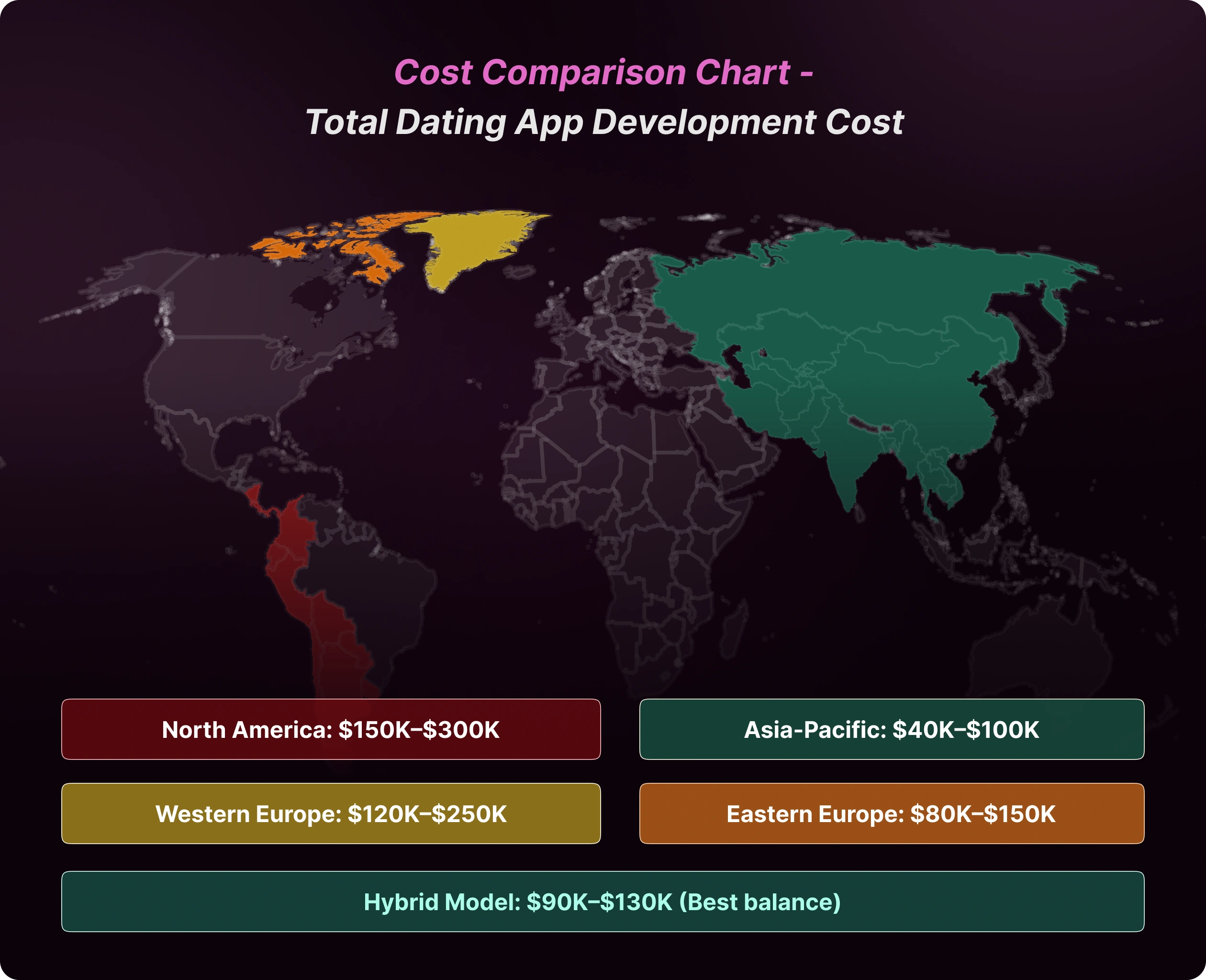
When planning to build a dating app, knowing the costs associated with dating app development is merely the first step. The location you select for the development of your app can significantly affect your budget while not necessarily compromising on quality. This section explores the ways in which the location of your development team will undoubtedly influence the overall cost and give you some intelligent strategies for creating a budget-friendly dating app without compromising on performance.
If you choose to hire app developers in North America or Western Europe, you can expect higher charges due to the wage standards in those regions.
Conversely, outsourcing to regions with more affordable labor, such as India or Eastern Europe, can lead to significant savings.
The cost to develop dating app solutions varies wildly across different regions. This breach arise from:
These geographic factors must be taken into consideration in a detailed cost breakdown of developing a dating app. For instance, an app that functions similarly to Tinder and costs $150,000 in Silicon Valley would only cost $60,000 in Eastern Europe.
Regional Cost Comparison for Development Teams
Best for: Startups wanting premium quality with timezone alignment
Ideal for: GDPR-compliant apps targeting European users
Good for: Quality-conscious projects with mid-range budgets
Best for: Feature development and QA testing
Hybrid Team Approach: Maximizing Value
Smart developers use a blended strategy to optimize the cost of building a dating app:
Core Team in Premium Location ($50,000-$80,000)
Extended Team in Cost-Effective Region ($30,000-$50,000)
Hidden Geographic Cost Factors
Build a cost-effective dating app while considering these given hidden geographic cost factors
1. Communication Overhead
2. Cultural Alignment
3. Payment Processing
This proves you can build a cost-effective dating app without compromising on the quality users expect.
Consider these factors when evaluating the dating app development cost breakdown by region:
Actionable Cost-Saving Tips
To optimize your cost of building a dating app:
To control cash flow, match your payments to your deliverables.
Geography significantly influences the overall cost breakdown of developing a dating app. While North America provides convenience, Eastern Europe and intelligent hybrid strategies can assist you in creating a cost-effective dating app without compromising quality.
The essential factor is aligning each app component with the region that offers the greatest value for that specific requirement. With adequate planning, you can decrease your dating app development costs by 30-50% while still producing a product that competes with the leading players in this profitable market.
By comprehending these geographic cost factors, you are now prepared to make more informed decisions regarding where and how to develop your dating app for optimal budget efficiency. Whether you opt for a premium single-region team or a mixed hybrid approach, this insight will enable you to maximize every dollar spent on your dating app development costs.
The cornerstone of any thriving dating application is its technological framework.
A meticulously selected tech stack for a dating app guarantees optimal performance, robust security, and the ability to scale, enabling users to connect, communicate, and match effortlessly without encountering technical issues.
Knowing how much does it cost to make a dating app needs a thorough examination of technology options. Your chosen stack greatly influences performance, scalability, and budget. Thoughtful selections can enhance cost efficiency while maintaining quality. Every decision, from backend infrastructure to third-party services, impacts both the initial development costs and the ongoing operational expenses.
Back-end development involves building the server side of your application, which encompasses databases, APIs, and user authentication systems.
It facilitates matchmaking, retains user information, manages chat functionalities, and guarantees seamless operation.
The cost of popular dating apps like Tinder will increase if you require a tailored backend solution or the incorporation of sophisticated features such as real-time messaging and geolocation tracking.
The foundation of your dating app determines scalability and maintenance costs:
These factors directly hit the cost to build a dating app, with AWS typically being the most expensive but most proficient option.
Your database selection can sway the cost to develop a dating app by $5,000-$20,000 in development effort alone.
For features like payment gateways, social media logins, chat/messaging APIs, Google Maps for geolocation, and analytics tools, the majority of dating applications need third-party integrations.
Although these integrations can conserve time by utilizing pre-existing services, they frequently incur their own expenses, such as licensing fees and charges for API usage.
Moreover, the incorporation of several third-party services can enhance the complexity of your application, necessitating additional developer time for both implementation and testing.
Essential add-ons that impact both functionality and budget:
The cost of developing a dating mobile app increases with each integration, and certain third-party services can require recurring membership fees. These services can vary from $10,000-$50,000 and affect the cost to develop a dating app all depending on the complexity and integrations.
A strategically planned stack can decrease the cost of developing a dating app by 20-30% without compromising quality.
Real-World Cost Breakdown
Total technology stack impact on the cost of creating a dating app: $28,000-$80,000
Prioritising strategic features over broad functionality is how successful dating apps gain popularity in the market. Dating app development costs can be cut by 40–60% by identifying which features increase user engagement rather than those that only draw investors. This will help speed up time-to-market and user acquisition.
The success of apps is determined by this core principle, which states that key features account for 70% of user engagement, convenience features account for 20%, and innovative improvements account for just 10%. This methodology helps business owners construct an affordable dating app that beats rivals in market share and stays within budgets for sustainable development.
Must-Have Features in Dating App
As the first step in using your dating site, user registration calls for a seamless onboarding procedure that collects essential data without being overbearing to new users.
Integrating social media, confirming emails, and gradually filling out profiles to encourage continuous interaction are all components of a successful implementation.
Ease of use and comprehensive user representation must be balanced in the profile creation feature. Important elements include basic demographics, relationship preferences, lifestyle information, and interesting biographical parts.
Basic functionality establishes the foundation for all future capabilities, however the cost of creating dating app profiles increases as customisation choices are added.
Difficult profile components, such compatibility tests or personality surveys, might wait until later in the process. Focus on creating profiles that, by providing essential information and an eye-catching layout, encourage deep connections.
The matching algorithm affects user happiness and retention rates by incorporating your application’s core value offering. In order to suggest appropriate matches, basic algorithms consider variables like age, geography, relationship desires, and common interests.
The feasible match collection and user preferences must be balanced in order to achieve efficient matching. While too broad recommendations can lower the impression of quality, excessively restricted criteria result in a lack of matches. Although basic closeness and preference-based matching can provide strong starting functionality, the complexity of a dating app’s matching algorithms increases with their sophistication.
Subsequent enhancements through machine learning can be integrated as user data is gathered. Initial algorithms should prioritize precise preference matching and geographic relevance over intricate behavioral analysis.
Real-time messaging improves engagement metrics and helps users communicate with one another, both of which are essential for an application’s success.
Text messaging, message history, and notification systems that alert users to new interactions are all included in basic messaging.
Strong backend systems that facilitate many conversations, guarantee message encryption, and offer offline message storage are essential to the messaging infrastructure.
Although the cost of creating a dating app with reliable messaging accounts for a significant portion of the overall development expenses, this feature directly affects user satisfaction and retention.
Advanced messaging functionalities such as message reactions, gif integration, or self-destructing messages can significantly improve the user experience in subsequent development stages.
Initially, the emphasis should be on establishing reliable and secure communication that fosters trust and encourages meaningful connections.
The search functionality enables users to find matches that go beyond algorithmic recommendations, thereby granting them greater control over their dating experience. Age range, location radius, relationship type, and basic lifestyle choices are important factors.
An effective search mechanism strikes a balance between user control and match quality, avoiding excessively restrictive filtering that may hinder connection opportunities. The cost breakdown for dating app development should emphasize filters that users genuinely utilize, rather than an extensive array of options that may complicate the user experience.
Advanced search features, such as education level, income range, or specific lifestyle preferences, can be incorporated based on user feedback and usage analytics. The initial implementation should concentrate on the most frequently used search criteria.
Visual representation plays a vital role in generating initial user interest and influencing match decisions, thereby making photo functionality essential for the success of dating applications. The fundamental implementation encompasses the ability to upload multiple photos, select a primary photo, and perform basic content moderation.
Photo verification systems foster user trust and minimize the presence of fake profiles, which has a direct effect on the safety of the app and user retention rates. The expenses associated with developing photo systems for dating apps include the necessary storage infrastructure, content moderation tools, and verification processes.
In later stages of development, advanced photo features such as AI-driven enhancements, video profiles, or augmented reality filters can significantly improve the user experience. Initially, the emphasis should be on ensuring reliable photo uploads, effective storage solutions, and basic moderation capabilities.
Nice-to-Have Features To Enhanced User Experience
Extended search functionalities that encompass education, profession, lifestyle choices, and specific preferences significantly enhance match quality for users who are actively engaged and also affect the cost to develop a dating app. While these features contribute to user satisfaction, they are not critical for initial market entry.
Incorporating audio messaging introduces a personal touch to conversations, setting your platform apart from competitors that rely solely on text. The implementation of this feature necessitates systems for audio storage, compression, and playback.
These monetization features are designed to elevate profile visibility and increase the likelihood of matches. By offering these premium options, you can generate revenue while simultaneously boosting user engagement among paying customers.
This feature provides message status indicators that inform users when their messages have been delivered and read. While it enhances clarity in communication, it may also induce anxiety in certain users.
Advanced verification systems that utilize photo comparison, social media validation, or document verification are essential. These features foster trust among users but necessitate a robust moderation infrastructure hence increase the overall cost of building a dating app.
Luxury Features: Innovation and Differentiation (10% Impact)
Video calling and virtual dating functionalities that became popular during the COVID-19 pandemic. Although innovative, these features necessitate a considerable investment in development and ongoing infrastructure expenses.
Machine learning algorithms that evaluate user behavior, conversation trends, and success rates to enhance match quality. These systems demand substantial data collection and technical proficiency.
Virtual reality dating settings that provide immersive interaction experiences. While they are at the forefront of technology, these features require specialized development expertise and hardware integration.
Decentralized identity verification systems that guarantee user authenticity through blockchain technology. These features attract tech-savvy individuals but involve intricate implementation processes.
Thorough tracking of user behavior, analysis of success rates, and predictive modeling. While beneficial for optimization, these features require significant resources.
Successful dating applications are launched with essential features, subsequently incorporating desirable enhancements informed by user feedback and usage analytics. This strategy reduces the initial development costs of dating apps while ensuring their viability in the market.
The secret to economic development is to resist the urge to create a fully-featured product from the outset.
✓ Focus on the fundamental features that promote user adoption, and then reinvest early profits into advanced functionalities that improve user experience and strengthen competitive positioning.
✓ It is important to note that applications overloaded with features can often bewilder users and complicate development.
✓ In contrast, simple and effectively executed core functionalities generally outperform intricate platforms that suffer from a poor user experience.
✓ Emphasize quality over quantity to optimize both user satisfaction and development efficiency.
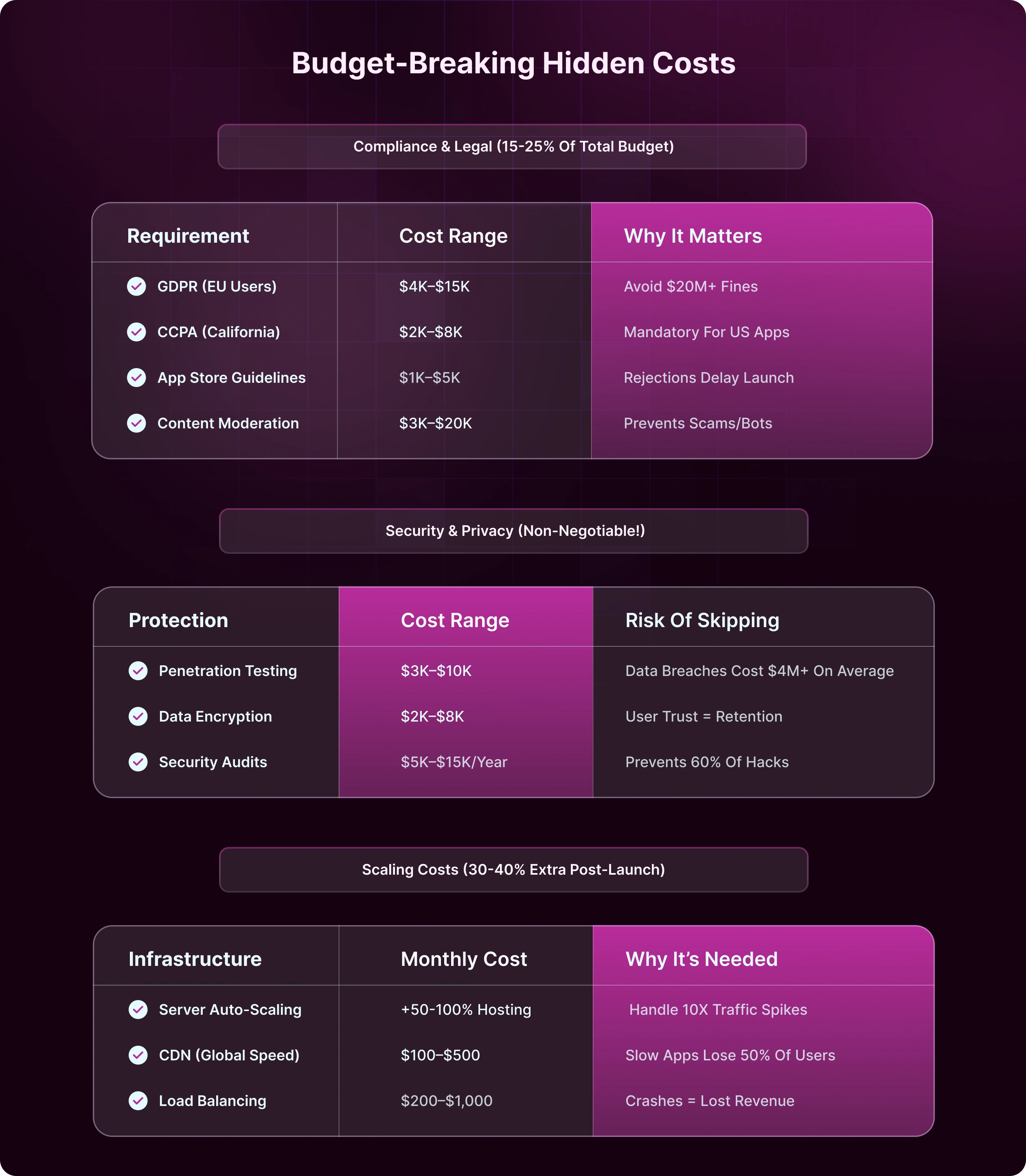
When initiating any mobile app development project, several companies tend to focus mainly on the initial development costs. Nevertheless, seasoned businesses understand that these preliminary costs frequently signify just the surface of a much larger issue. The true difficulty resides in managing the frequently ignored hidden expenses that can significantly affect your project’s budget and schedule.
Henceforth, understanding the total dating app development cost is essential for entrepreneurs venturing into this competitive industry. This section unfolds all financial elements, juxtaposing them with the expenses of well-known dating applications while uncovering vital budgetary factors.
To build a dating app we must navigate complex and strict regulations that significantly impact your app development budget:
► GDPR Compliance ($4,000-$15,000) – It is crucial for European user data protection
► CCPA Compliance ($2,000-$8,000) – It is required for California users
► App Store Guidelines ($1,000-$5,000) – to ensure your app meets Apple/Google strict standards
► Content Moderation (3,000-$20,000) – It is important for user safety and platform integrity
These crucial compliance and legal cost requirements often surprise entrepreneurs, adding 15-25% to the starting dating app development cost.
Although fundamental security protocols may appear adequate, a data breach can result in devastating costs, such as penalties, harm to reputation, and the necessity for urgent fixes.
Security breaches or hacker attacks can destroy your dating platform’s reputation. Therefore these key protections must be taken into account:
► SSL Certificates ($100-$500/year) – It is a basic but important encryption for data transfers
► Penetration Testing ($3,000-$10,000) – It helps identifying vulnerabilities before hackers attack
► Data Encryption ($2,000-$8,000) – It helps protecting sensitive user data
► Security Audits ($5,000-$15,000/year) – Give ongoing protection maintenance for better security.
Compared to the cost of popular dating apps like Tinder, Bumble spends millions annually on these security, hence proving they are essential investments. For instance, in a project related to mobile payments, we executed end-to-end encryption and performed thorough penetration testing prior to the app’s launch. By identifying vulnerabilities at an early stage, we prevented our client from incurring potential costs associated with emergency patches and regulatory penalties.
Below are the expansion that experience unexpected infrastructure costs:
► Server Auto-Scaling (+50-100% hosting costs) – It works handling peak traffic periods
► Database Optimization ($3,000-$10,000) – It help you keep performance smooth
► CDN Implementation ($100-$500/month) – To get faster global content delivery
► Load Balancing ($200-$1,000/month) – It help distributing server workload efficiently
These scaling expenses frequently add up to 30-40% of the original cost of developing a dating application.
Comparing to Industry Leaders
The costs related with well-known dating applications offer significant benchmarks:
For example:
► Tinder’s initial development reportedly cost around $500,000+
► Bumble invested $1M+ in its first year of development
Nonetheless, their continuous maintenance costs for a dating app are more informative:
► $50,000-$100,000/month for major platforms
► $10,000-$30,000/month for mid-sized apps
► $3,000-$8,000/month for startups
In order for the application to achieve success, it requires continuous infrastructure, maintenance, and marketing, as recommended by a mobile application development services provider.
Establishing a budget enables you to comprehend how all components interconnect and helps you in making informed decisions for the development of your dating application.
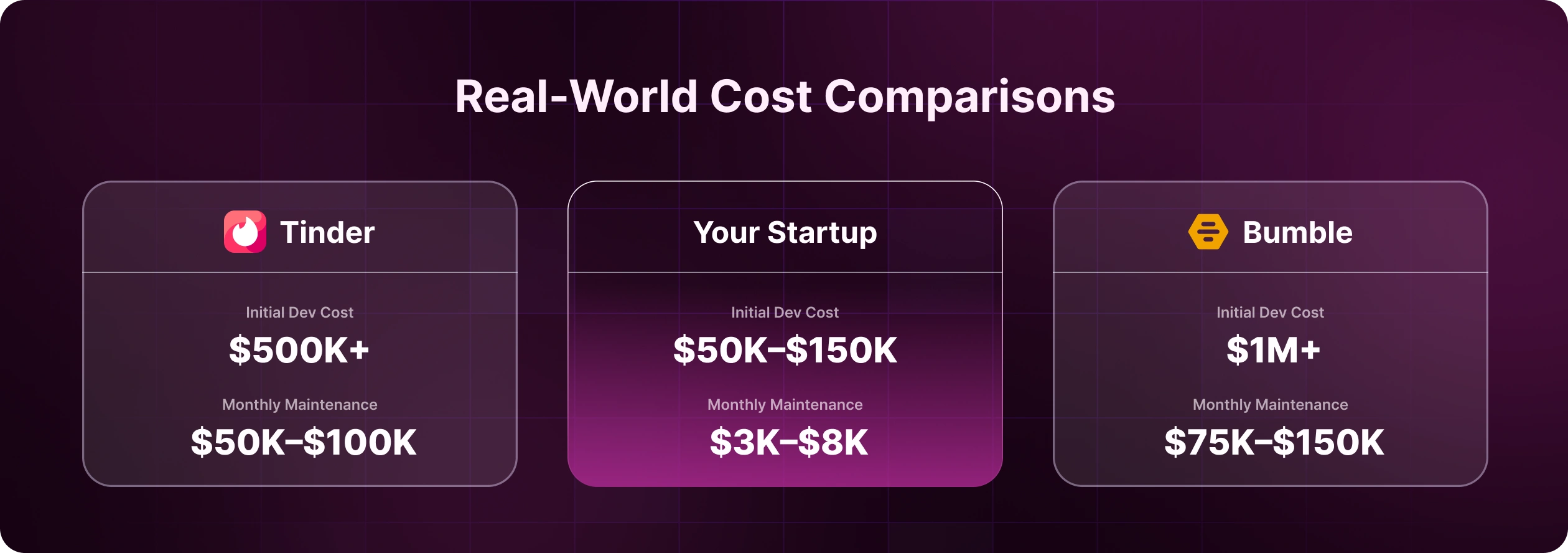
To enhance the cost-effectiveness of your dating app development:
✓ Implement phased feature rollouts to distribute expenses over time.
✓ Make early investments in scalable architecture to minimize future costs.
✓ Set aside 20-30% of your budget for unforeseen expenses.
✓ Emphasize security measures to prevent expensive breaches.
Typically, the annual maintenance cost for a dating app is around 15-20% of the initial development cost. For an app priced at $100,000, anticipate annual expenses of $15,000-$20,000 for hosting, updates, and support.
Key Takeaways
✓ The actual expenses associated with dating app development encompass numerous concealed elements that extend beyond mere coding.
✓ Ongoing maintenance expenses are significant and persistent.
✓ Leading companies invest heavily in compliance and scaling efforts.
✓ Effective planning can avert budget excesses.
By comprehending these financial truths, you can more effectively strategize the total lifecycle costs of your dating app project, from development to scaling and maintenance.
Balancing the speed of development with budget constraints is a fundamental aspect for anyone intending to create a dating application. The timeline selected not only influences your speed to market but can also significantly impact the overall quality and cost of building a dating app. Below is an in-depth exploration of how the pace of development and resource distribution affect the cost of dating app development.
The speed at which you develop your app directly influences your budget. Below is an overview of how each development option typically correlates with costs and results:
► Characteristics: Full team engagement; multiple teams collaborating simultaneously, working overtime, or utilizing “follow-the-sun” outsourcing strategies.
► Cost Impact: A premium will be incurred — anticipate the total budget to be 50-70% higher than the standard.
► Reason for the Premium?: Enhanced timelines need additional resources, higher hourly rates for expedited work, and potentially compromises in code quality or feature refinement to adhere to stringent deadlines.
► Best suited for: Startups requiring a swift market entry or MVP validation in a highly competitive landscape.
► Characteristics: A balanced pace; a conventional timeline for most app developments, emphasizing quality and consistent progress.
► Cost Impact: The budget remains aligned with the baseline estimate for your feature set and geographical area—no rush premiums or discounts for expedited timelines.
► Best suited for: Projects that aim to optimize both quality and budget without facing intense time constraints.
► Characteristics: A methodical, phased approach. Potential utilization of smaller teams, sequential sprints, or extended MVP validation periods.
► Cost Impact: Lengthening timelines can lead to a reduction in total expenditure by 20-30% as resource usage is spread out, lower rates are negotiated, and overtime or staff fatigue is avoided.
► Risks: A longer time-to-market may allow competitors to advance ahead; there is also the risk of shifts in technology or trends.
► Best suited for: Organizations that prioritize cost efficiency or those that are iterating alongside comprehensive research.
Knowing when and how much of your money will be spent on each step is the foundation of strategic budgeting. This is a breakdown based on industry:
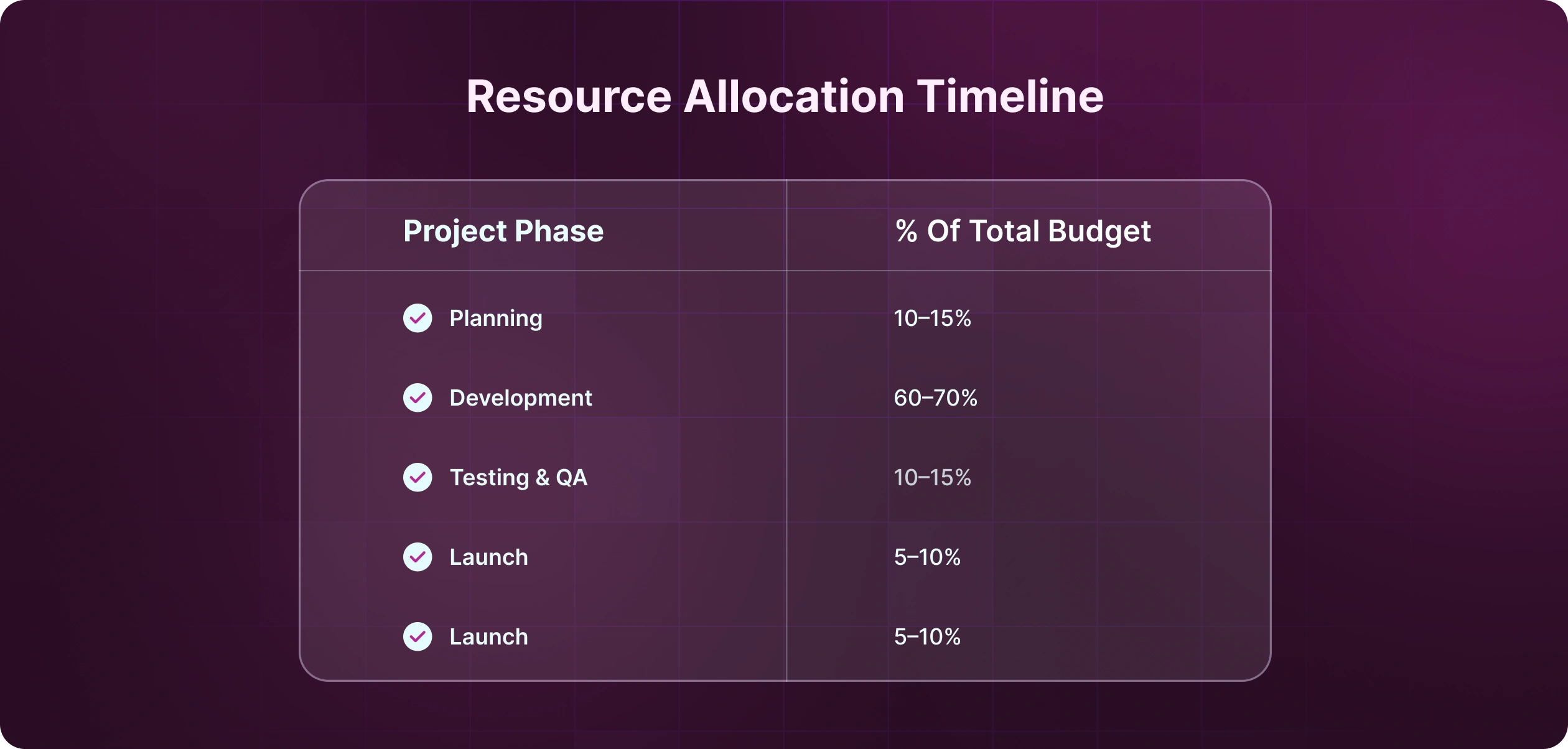
Explanation by Phase:
► Planning (10–15%): This phase encompasses market research, product design, feature definition, and budgeting to establish a solid groundwork. Neglecting this stage may lead to big cost overruns in the future.
► Development (60–70%): Remember the majority of your budget is allocated to coding, feature integration, and the creation of UI/UX as said earlier.
► Testing & QA (10–15%): Thorough and robust quality assurance, bug resolution, and user feedback mechanisms are crucial for a successful launch and to increase the dating app development cost.
► Launch (5–10%): This stage involves app store submissions, marketing initiatives, and the initial onboarding of users.
► Post-launch (50–100% of original budget in Year 1): Continuous expenses include maintenance, server hosting, feature enhancements, user assistance, and infrastructure scaling is also one of the major dating app development cost factors. Popular applications frequently necessitate reinvestment that equals or exceeds development costs, particularly as the user base expands.
Key Insights-
✓ Faster development significantly increases the cost of building dating app, yet it hastens market entry.
✓ Prolonged and gradual builds reduce expenses but may lead to market delays
✓ Resource distribution must be strategically planned from the outset, incorporating realistic financial projections for scaling and support after launch.
✓ To achieve long-term success, it is essential to align your timeline aspirations with your available budget and future growth plans.
Choosing the right timeline involves more than just financial considerations; it encompasses achieving the required milestones for your business objectives and fulfilling user commitments. By considering the speed-cost relationship, you can make more informed investments, facilitate strategic market entry, and enhance the likelihood of enduring success.
Creating a dating application needs strategic financial planning, particularly as emerging technologies and regulations impact the cost of building a dating app. Regardless of whether you are a startup or a well-established enterprise, knowing the costs involved in developing a dating app in 2025 is essential to prevent budget overruns. In the following sections, we will analyze a few most recent trends that are affecting the cost breakdown of dating app development and offer insights on how to optimize expenses while maintaining quality.
Trends Influencing Dating App Development Costs in 2025
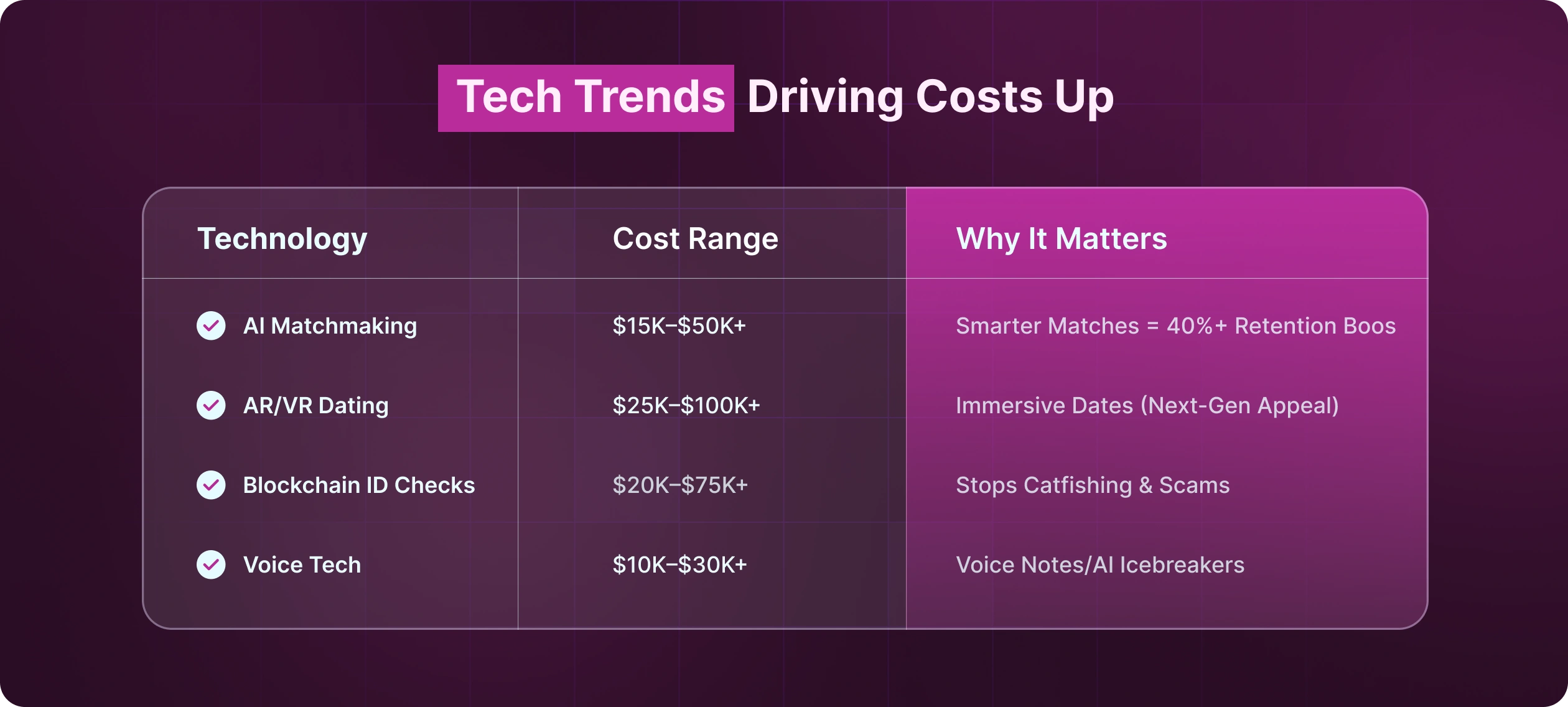
The integration of advanced features has a considerable impact on the budget associated with developing a dating application. Below is an overview of how emerging technologies affect cost to develop a dating app:
► AI Integration ($15,000–$50,000+)
The use of AI for matchmaking, chatbots, and behavioral analysis enhances user engagement; however, it needs a major investment in machine learning models and data processing that affect the overall cost to develop dating app.
► AR/VR Features ($25,000–$100,000+)
The rise of virtual dating experiences and immersive profiles is notable, yet the creation of 3D environments and real-time interactions leads to increased the cost of building a dating app.
► Blockchain Verification ($20,000–$75,000+)
Implementing secure identity verification and fraud prevention through blockchain raises additional expenses but also brings trust and security.
► Voice Technology ($10,000–$30,000+)
The increasing popularity of voice notes and AI-driven voice matching is on the hype, which requires further backend development and too is the dating app development cost factors.
These advancements can enhance the user experience; however, they must be included in the cost analysis of dating app development to prevent unexpected financial burdens.
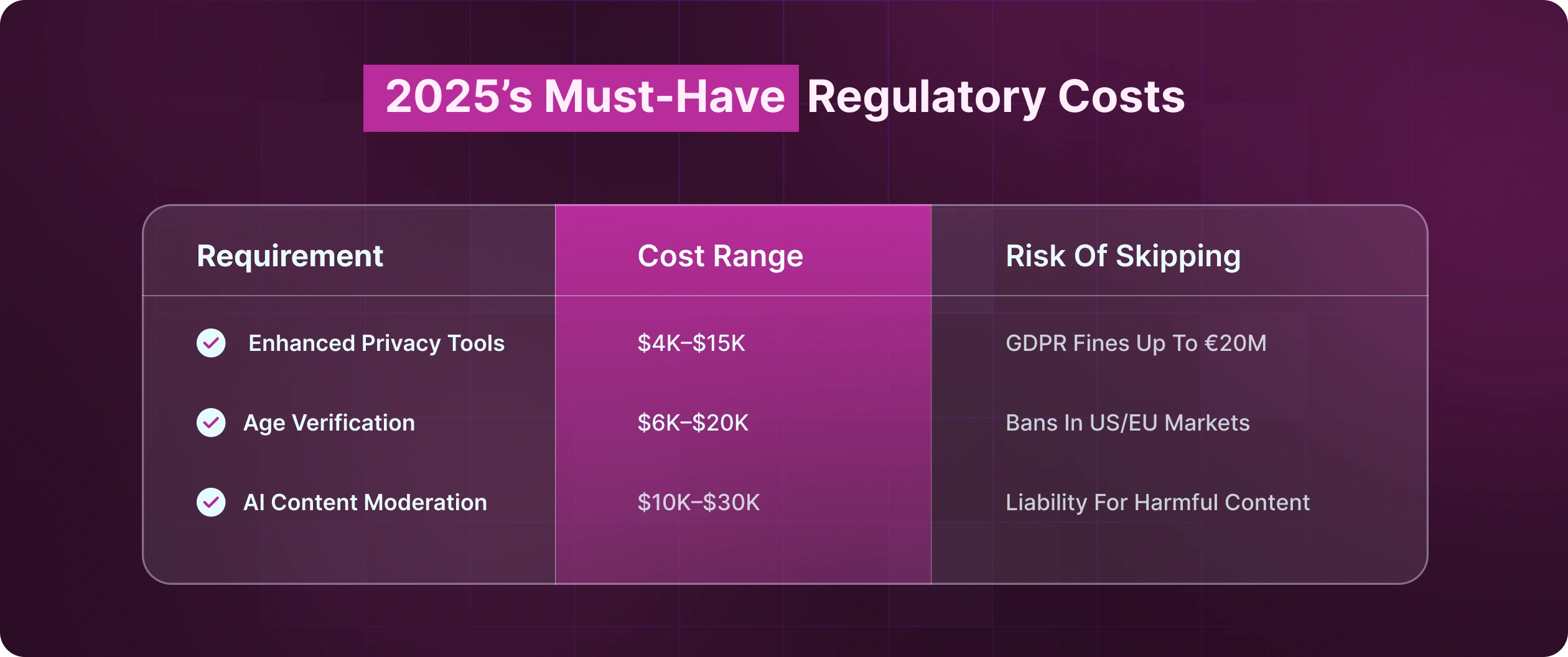
Global privacy regulations and platform safety standards need that dating applications in 2025 exceed basic requirements. This also affects costs:
► Enhanced Privacy Features: $4,000–$15,000. Adhering to data security laws is essential, requiring investments in encryption, user consent management, and transparency.
► Age Verification Systems: $6,000–$20,000. Required in numerous areas, these systems confirm user age during the onboarding process, adding additional lines to your development budget.
► Content Moderation AI: $10,000–$30,000. This is because the automated systems designed to identify and block inappropriate content are vital for user safety and legal compliance.
These regulatory obligations directly affect the cost to develop dating app and are non-negotiable. Neglecting to account for them may result in further redesign costs and legal issues in the future.
Although more advanced features enhance user retention, not every application requires AI or blockchain technology. Here are strategies to optimize expenditures and build a cost-effective dating app.
When planning to build a dating app, it is essential to choose the right dating app development company to guarantee success while also optimizing the cost of building a dating app. A reliable team can fasten the process, prevent expensive errors, and produce a high-quality product. Below are guidelines on how to assess potential partners and steer clear of frequent mistakes.
Cost Structure Clarity – The cost of dating app development can vary significantly ($50K–$300K+). It is crucial that the agency provides dating app development cost breakdown (UI/UX design, backend development, third-party API integrations, etc.) to prevent any unforeseen costs.
Red Flags to Avoid
Final Tips
✓ Compare several quotes to find a balance between the cost of dating app development and the level of expertise.
✓ Request client references to confirm reliability.
✓ Begin with a Minimum Viable Product (MVP) to assess the market before committing to a full-scale investment.
Selecting the right partner is essential to ensure your app is competitive, scalable, and delivered within budget—these are crucial elements for capturing a share of the rapidly growing online dating market. I hope with this you get the answer to the question on how much does it cost to create a dating app.
The online dating industry is advancing swiftly, with Artificial Intelligence (AI) leading this change. AI-driven dating applications are enhancing user experiences, refining match precision, and boosting engagement levels. If you are considering the development of a next-generation dating app, incorporating AI has become essential rather than optional. With AI-driven dating apps seeing a 35% rise in downloads and 60% of users reporting more meaningful connections and intelligent matchmaking.
Likewise, at Dev Story, we utilize top-notch AI technologies to develop more intelligent, secure, and captivating dating applications that differentiate themselves in a competitive marketplace. Here’s our unique approach.
Instead of random swiping, our AI forecasts compatibility based on:
✓ Facial appeal (utilizing deep learning)
✓ Common hobbies & interests
✓ Analysis of communication styles
We integrate voice recognition & liveness detection to guarantee authentic profiles, minimizing fake accounts.
Our AI recommends optimal subscription plans according to user spending patterns, enhancing revenue.
AI observes discussions to:
✓ Identify toxic behavior
✓ Propose responses to maintain chat engagement
✓ Notify users if a match appears disinterested
Reasons to Select Dev Story for Your AI Dating Application:
Don’t just build a dating app—build the FUTURE of dating with Dev Story!
Simply having a brilliant app idea isn’t enough – the market is saturated with unsuccessful dating applications that failed to gain popularity. Similar to any revolutionary invention or patent, your creation holds no value if it remains undiscovered by users. Achieving success demands more than mere development; it requires strategic marketing, viral elements, and continuous user acquisition from the day one.
Additionally, it is important to recognize that you cannot simply conjure an app out of thin air. Transforming an idea into a functional application that is utilized by individuals across the region or even globally demands time, financial investment, and resources.
Creating a successful dating app that not only draws users in but also delivers an outstanding user experience can prove to be a challenging endeavor.
The challenge lies in understanding where to start and how to navigate the essential steps to develop a dating app that stands out in a highly competitive market.
It is vital to grasp the complete dating app development process, which includes the various stages involved, the associated costs, and other critical factors to ensure the success of your dating application. With the rise of video dating, the online dating sector has the opportunity to offer users a more interactive and dynamic experience.
Choosing a right dating app development company will help those looking to create a high-quality app that aligns with their vision.
Development companies give quality design and help reduce dating app development costs, as well as offer testing and customization services as needed. The result will be a highly tailored app equipped with advanced features and scalability. The price can range from $15,000 to $50,000 depending on the complexity of the applications.
If budget is a concern for you, then Dev Story presents a practical choice. You will get a fully functional app, with customization and top-notch features.
If you are prepared to take the leap and bring your dating app idea to life our team at Dev Story is ready to assist. Our Dating app developers specialize in creating innovative and user-friendly dating solutions customized to your vision and budget.
Still thinking of how to build a dating app? Connect with our team of experts
What are you waiting for? Let’s build a Dating App that not only thrives- But DOMINATES!